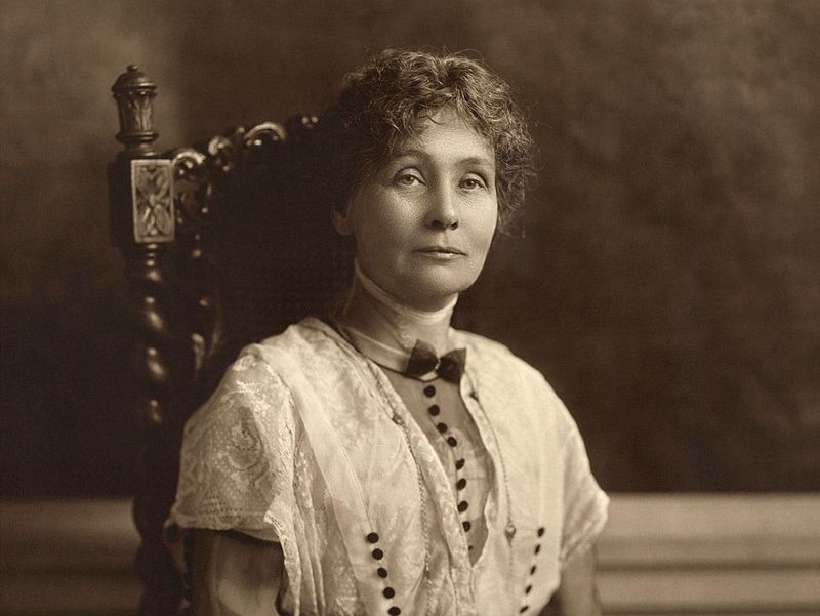Emmeline Pankhurst: Leading the battle for Women's right to vote
Home / Non Fiction for Kids / Biographies for Kids / Emmeline Pankhurst: Leading the battle for Women's right to vote
Emmeline Pankhurst (1858 - 1928):
It was a little over 100 years ago that women were first allowed to vote in the United Kingdom of Britain. Till 1918, only men were allowed to vote in the British elections to Parliament. The battle for universal suffrage, or men and women voting as equals, was led by the British political activist Emmeline Pankhurst. She fought a long and hard battle during which she was arrested more than seven times, and had to leave her three daughters with cousins so that she could continue the fight.
Emmeline Pankhurst was born Emmeline Goulden in Manchester. She was the eldest of five daughters. Although Emmeline started reading at the early age of three years, her parents chose not to give her a formal education. It was common at the time for women to be brought up to look after the home, and leave paid work to men. Like most women from well-to-do homes, Emmeline was sent to a finishing school in Paris. Luckily the headmaster of her finishing school believed that education was important, irrespective of gender. The school curriculum included subjects like chemistry and accounts.
Emmeline’s parents were politically active, and on her return from Paris, she went with her mother to a conference on women’s voting rights. Emmeline later said that it was the moment that made her take up the cause of women’s voting rights.
Her political life began with the Independent Labour Party. Emmeline was excited about the issues they promised to tackle. Her first task involved giving the unemployed and poor food. During this time she understood their troubles in detail. She saw women and children being exploited as labour. She believed that the right for women to vote would change these conditions.

When the Independent Labour Party refused to focus on women’s voting rights, Emmeline started her own party. This was called the Women’s Social and Political Union or WSPU. It began with peaceful speeches and petitions but found that violent resistance was the only way to be seen as a real political movement.
Over the next three years, from 1903 to 1906, Emmeline grew the movement alongside her daughters Christabel and Sylvia. They were arrested numerous times before the right to vote for women finally became law 12 years later. Emmeline personally was arrested seven times during this period.
This victory did not come easy. The first step was a protest organised by WSPU. In 1908, on the 26th of June, 500,000 activists rallied in Hyde Park to demand votes for women. Despite this, there was an air of general indifference by the members of parliament. Frustrated by this, the WSPU pushed their speeches closer to the parliament and the home of the prime minister. Some of the members even threw rocks and smashed windows. There were numerous arrests.
To support the arrested, many of the activists began holding hunger strikes. The hunger strikes were so widespread that authorities had to force-feed hundreds of people. This led to widespread condemnation in the media and put the idea of votes for women on national and international television.
During this time Emmeline had to sell her house and left her children in the care of cousins so that she could travel and give speeches on the right to vote for women.
Despite the battle, the Women’s Suffrage Bill was voted out by members of parliament. In response, Emmeline organized a peaceful protest which was turned violent by the police. Along with her comrades from WSPU, she was arrested for extensive property damage. Inside Halloway prison, Emmeline went on a hunger strike and had to be medically force-fed. Eventually she was released along with the other activists. During this time, the WSPU had moved on from violence to fire-bombing. They would repeatedly burn things in areas around the members of parliament and leave notes about the right of women to vote. Emmeline supported them verbally but denied this was being done on behalf of the WSPU.
The endless fighting, petitions, speeches and rallies only paid off in 1918 when universal suffrage was finally enacted. An act of parliament granted votes to all men over the age of 21 and women over the age of 30. Ten years later, another act of parliament gave equal rights to vote to both men and women at the age of 21. Unfortunately, Emmeline died a few weeks before this bill came into force. She was 70 years old.
Emmeline Pankhurst’s life is a story of deep belief in equality and her unwavering strength in fighting for it. She fought the members of parliaments, members of her party and members of her own family but never gave up on her idea of equality. Emmeline Pankhurst was a central figure in the women’s suffrage movement and played a key role in helping women get the right to vote.
Born: 15 July, 1858, England
Died: 14 June, 1928, England
Education: École Normale de Neuilly (1872-1874)
Major contribution: Women’s suffrage – women’s right to vote
More about Emmeline Pankhurst
844 words |
8 minutes
Readability:
Grade 8 (13-14 year old children)
Based on Flesch–Kincaid readability scores
Filed under: biographies
Tags: #women's empowerment, #british politics, #voting rights, #women's liberation movement, #women's suffrage